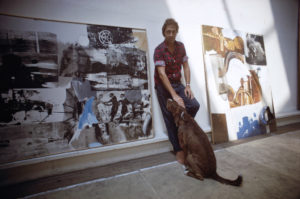Ownership History
San Francisco Museum of Modern Art, fractional and promised gift of Helen and Charles Schwab, 1998
Exhibition History
The Obsessive Image: 1960–1968, Institute of Contemporary Arts, London, April 10–May 29, 1968.
The Second Hiroshima Art Prize: Robert Rauschenberg, Hiroshima City Museum of Contemporary Art, November 3, 1993–January 16, 1994.
Untitled installation, Staatsgalerie Moderner Kunst, Munich, September 10, 1994–Spring 1995.
Robert Rauschenberg: A Retrospective, Solomon R. Guggenheim Museum, New York, September 19, 1997–January 7, 1998. Traveled to: The Menil Collection, Houston, February 13–May 17, 1998; Museum Ludwig, Cologne, Germany, June 27–October 11, 1998; Guggenheim Museum Bilbao, Spain, November 21, 1998–March 7, 1999.
Robert Rauschenberg, San Francisco Museum of Modern Art, May 7–September 7, 1999.
75 Years of Looking Forward: The Anniversary Show, San Francisco Museum of Modern Art, December 19, 2009–January 16, 2011.
In addition to appearing in the special exhibitions listed above, Scanning was shown in SFMOMA’s galleries in 1999 and 2000 as part of rotating presentations of the permanent collection.
This listing has been reviewed and is complete as of August 31, 2016.
Publication History
Mario Amaya,The Obsessive Image, 1960–1968 (London: Institute of Contemporary Art, 1968), 65.
Roni Feinstein, ed., Robert Rauschenberg: The Silkscreen Paintings, 1962–1964 (New York: Whitney Museum of American Art, 1990), 141, 150 (ill.).
Seiji Oshima, Marjorie Welish, Takeshi Yoshizumi, et al., The Second Hiroshima Art Prize: Robert Rauschenberg (Hiroshima: Hiroshima City Museum of Contemporary Art, 1993), 75 (ill.), 174.
Walter Hopps and Susan Davidson, eds., Robert Rauschenberg: A Retrospective (New York: Solomon R. Guggenheim Museum, 1997), 178 (ill.).
Janet Tyson, “Robert Rauschenberg reste saisi,” Le Journal des Arts 56 (March 13, 1998).
Carol Vogel, “Left Their Art in San Francisco,” New York Times, June 5, 1998, (ill.).
Sam Hunter, Robert Rauschenberg (New York: Rizzoli, 1999), 62 (ill.), 126.
Robert Rauschenberg, video interview by David Ross, Walter Hopps, Gary Garrels, and Peter Samis, San Francisco Museum of Modern Art, May 6, 1999. Unpublished transcript at the SFMOMA Research Library and Archives, N 6537 .R27 A35 1999a, 58–66.
Kenneth Baker, “Rauschenberg Coup at SFMOMA: ‘Port of Entry’ a Major New Work,” San Francisco Chronicle, May 8, 1999.
David Bonetti, “Rauschenberg Coup Cements SFMOMA’s Ascendance,” San Francisco Examiner, May 21, 1999, (ill.).
Branden W. Joseph, Random Order: Robert Rauschenberg and the Neo-Avant-Garde (Cambridge, MA: MIT, 2003), 190 (ill.).
Rauschenberg Express (Madrid: Museo Thyssen-Bornemisza, 2006), 17n1, 18 (ill.).
Sam Hunter, Robert Rauschenberg: Works, Writings and Interviews (Barcelona: Ediciones Polígrafa, 2006), 89 (ill.).
“SFMOMA 75th Anniversary: David White,” interview conducted by Richard Cándida Smith, Sarah Roberts, Peter Samis, and Jill Sterrett, 2009, Regional Oral History Office, The Bancroft Library, University of California, Berkeley, 2010, 44. Accessed January 3, 2013. https://bancroft.berkeley.edu/ROHO/projects/sfmoma/interviews.html.
Janet Bishop, Corey Keller, and Sarah Roberts, eds., San Francisco Museum of Modern Art: 75 Years of Looking Forward (San Francisco: San Francisco Museum of Modern Art, 2009), 149 (ill.), 150, 432.
Susan Davidson, “Robert Rauschenberg,” Guggenheim Museum Bilbao Collection (Bilbao: Guggenheim Bilbao, 2009), 97n43.
This listing has been reviewed and is complete as of August 31, 2016.

